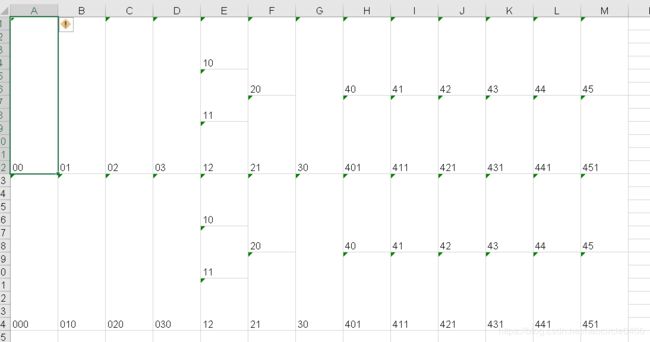一对多关系实体类对象excel导出
package org.ibas.util;
import java.io.File;
import java.io.FileOutputStream;
import java.util.ArrayList;
import java.util.HashMap;
import java.util.List;
import org.apache.poi.hssf.usermodel.HSSFRow;
import org.apache.poi.hssf.usermodel.HSSFSheet;
import org.apache.poi.hssf.usermodel.HSSFWorkbook;
import org.apache.poi.ss.util.CellRangeAddress;
//两个事件的测试
public class OtherSolutiaonFor2Event {
public static void main(String[] agrs) throws Exception {
String filenameZip = "D://testCascade1111235888999.xls";
File pathFile = new File(filenameZip);
if (pathFile.exists()) {
pathFile.delete();// 删除文件
}
HSSFWorkbook wb = new HSSFWorkbook();
HSSFSheet sheet = wb.createSheet();
Entity0 e0 = new Entity0("00", "01", "02", "03");
Entity0 e00 = new Entity0("000", "010", "020", "030");
Entity1 e10 = new Entity1("10");
Entity1 e11 = new Entity1("11");
Entity1 e12 = new Entity1("12");
Entity2 e20 = new Entity2("20");
Entity2 e21 = new Entity2("21");
Entity3 e30 = new Entity3("30");
Entity4 e40 = new Entity4("40", "41", "42", "43", "44", "45");
Entity4 e41 = new Entity4("401", "411", "421", "431", "441", "451");
Entity4 e42 = new Entity4("40", "41", "42", "43", "44", "45");
Entity4 e43 = new Entity4("40", "41", "42", "43", "44", "45");
List
list0.add(e0);
list0.add(e00);
int startRowForMA = 0;
// 将非0,非1的各个的大小值添加到一个集合中,求最小公倍数
for (int i = 0; i < list0.size(); i++) { // 事件编号 从0开始,一直向后
// 每个事件的相关类对应的单元格数
// 查询得到所有的list,计算每一个事件对应的multiple
List
list1.add(e10);
list1.add(e11);
list1.add(e12);
List
list2.add(e20);
list2.add(e21);
List
list3.add(e30);
List
list4.add(e40);
list4.add(e41);
int[] sizeArray = new int[13]; // 对应列的合并后的单元格的个数,13个属性,下标为属性下标
sizeArray[0] = 1;
sizeArray[1] = 1;
sizeArray[2] = 1;
sizeArray[3] = 1;
sizeArray[4] = list1.size();
sizeArray[5] = list2.size();
sizeArray[6] = list3.size();
sizeArray[7] = list4.size();
sizeArray[8] = list4.size();
sizeArray[9] = list4.size();
sizeArray[10] = list4.size();
sizeArray[11] = list4.size();
sizeArray[12] = list4.size();
List
sizeList.add(1);
sizeList.add(3);
sizeList.add(3);
sizeList.add(1);
sizeList.add(4);
int[] entityLatNum = new int[5]; // 第i(数组下标)个类的对象的个数
entityLatNum[0] = 1;
entityLatNum[1] = list1.size();
entityLatNum[2] = list2.size();
entityLatNum[3] = list3.size();
entityLatNum[4] = list4.size();
// 求k数的最小公倍数
int multiple = 1;
if (sizeList != null) {
multiple = ComputeLeastCommonMultiple.getLeastCommonMultiple((List
}
int[] latnum = new int[13]; // 每个列所占的单元格的个数
for (int u = 0; u < 13; u++) { // 每个类的单元格所占的行数 13位列数
if (sizeArray[u] != 0) {
latnum[u] = multiple / sizeArray[u];
} else {
latnum[u] = sizeArray[u];
}
}
// 将0到3扩展到0到6,共7个,每列单元格的格子数
int[] collatNum = new int[13];
for (int u = 0; u < 13; u++) {
collatNum[u] = latnum[u];
}
for (int j = 0; j < 13; j++) { // 列数,最小公倍数(0,12)
if (sizeArray[j] != 0) { // 每列单元格的个数
for (int k = 0; k < sizeArray[j]; k++) { // k为合并的格子的索引,第j列的第k个数,collatNum[j]第j列每个单元格的个数
Integer startRow = startRowForMA + collatNum[j] * (k);
Integer endRow = startRowForMA + collatNum[j] * (k + 1) - 1;
Integer startCol = j;
Integer endCol = j;
if (!(startRow.equals(endRow) && startCol.equals(endCol))) { // 不为空则合并
CellRangeAddress region1 = new CellRangeAddress(startRow, endRow, startCol, endCol);
sheet.addMergedRegion(region1);
}
}
}
// sizeArray[j]为零说明,第j类所属的对象的大小为0,前面未做任何处理
if (sizeArray[0] != 0 && sizeArray[j] == 0) { // 第一个list不为空,其它类的list为空情况
Integer startRow = startRowForMA;
Integer endRow = startRowForMA + multiple - 1;
Integer startCol = j;
Integer endCol = j;
if (!(startRow.equals(endRow) && startCol.equals(endCol))) { // 不为空则合并
CellRangeAddress region1 = new CellRangeAddress(startRow, endRow, startCol, endCol);
sheet.addMergedRegion(region1);
}
}
}
// 赋值
// latnum[u] 每个合并后的单元格所占的行数
// 对每个事件的单元格赋值
Entity0 en0 = list0.get(i);
HSSFRow r0 = sheet.getRow(startRowForMA);
if (r0 == null) {
r0 = sheet.createRow(startRowForMA);
}
r0.createCell(0).setCellValue(en0.getValue00());
r0.createCell(1).setCellValue(en0.getValue01());
r0.createCell(2).setCellValue(en0.getValue02());
r0.createCell(3).setCellValue(en0.getValue03());
int startRow1 = startRowForMA;
int startRow2 = startRowForMA;
int startRow3 = startRowForMA;
int startRow4 = startRowForMA;
if (list1.size() > 0) {
for (Entity1 en1 : list1) {
HSSFRow r1 = sheet.getRow(startRow1);
if (r1 == null) {
r1 = sheet.createRow(startRow1);
}
if (en1.getValue10() != null) {
r1.createCell(4).setCellValue(en1.getValue10());
}
startRow1 = startRow1 + multiple / entityLatNum[1];
}
}
if (list2.size() > 0) {
for (Entity2 en2 : list2) {
HSSFRow r2 = sheet.getRow(startRow2);
if (r2 == null) {
r2 = sheet.createRow(startRow2);
}
r2.createCell(5).setCellValue(en2.getValue20());
startRow2 = startRow2 + multiple / entityLatNum[2];
}
}
if (list3.size() > 0) {
for (Entity3 en3 : list3) {
HSSFRow r3 = sheet.getRow(startRow3);
if (r3 == null) {
r3 = sheet.createRow(startRow3);
}
r3.createCell(6).setCellValue(en3.getValue30());
startRow3 = startRow3 + multiple / entityLatNum[3];
}
}
if (list4.size() > 0) {
for (Entity4 en4 : list4) {
HSSFRow r4 = sheet.getRow(startRow4);
if (r4 == null) {
r4 = sheet.createRow(startRow4);
}
r4.createCell(7).setCellValue(en4.getValue40());
r4.createCell(8).setCellValue(en4.getValue41());
r4.createCell(9).setCellValue(en4.getValue42());
r4.createCell(10).setCellValue(en4.getValue43());
r4.createCell(11).setCellValue(en4.getValue44());
r4.createCell(12).setCellValue(en4.getValue45());
startRow4 = startRow4 + multiple / entityLatNum[4];
}
}
startRowForMA = startRowForMA + multiple;
}
FileOutputStream fileOut;
try {
fileOut = new FileOutputStream("D:/testCascade1111235888999.xls");
wb.write(fileOut);
System.out.println("qqqq");
fileOut.close();
} catch (Exception e) {
e.printStackTrace();
}
}
}
效果如下:
注意:
合并单元格需要知道起始行,起始列,终止行,终止列,对单个单元格(起始行,起始列)赋值即可渲染整个合并的单元格。
